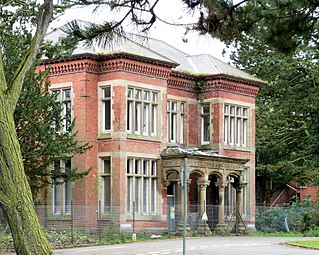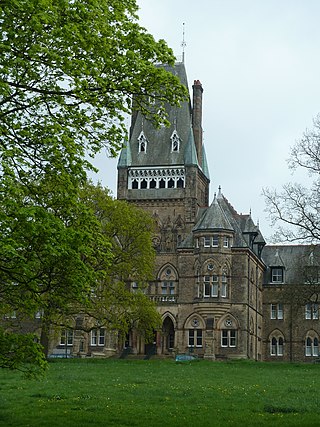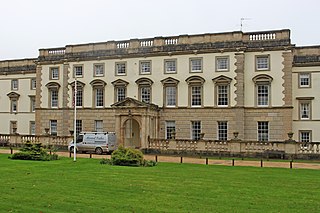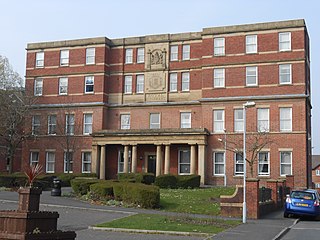
Glenside campus is the home of the Faculty of Health and Applied Sciences at the University of the West of England, in Bristol. It is located on Blackberry Hill in the suburb of Fishponds. Its clocktower is a prominent landmark, visible from the M32 motorway. Several of the buildings on the site are Grade II listed.

Claybury Hospital was a psychiatric hospital in Woodford Bridge, London. It was built to a design by the English architect George Thomas Hine who was a prolific Victorian architect of hospital buildings. It was opened in 1893 making it the Fifth Middlesex County Asylum. Historic England identified the hospital as being "the most important asylum built in England after 1875".

Central Hospital was a psychiatric hospital located in Hatton, Warwickshire, England.

Whittingham Hospital was a psychiatric hospital in the parish of Whittingham, near Preston, Lancashire, England. The hospital opened in 1873 as the Fourth Lancashire County Asylum and grew to be the largest mental hospital in Britain, and pioneered the use of electroencephalograms (EEGs). It closed in 1995.

Fairfield Hospital in Fairfield, Bedfordshire, England was a psychiatric hospital from 1860 to 1999. It is a Grade II listed building.

Roundhill Crescent is a late-19th-century housing development in Round Hill, an inner suburb of the English coastal city of Brighton and Hove. Partly developed in the 1860s with large terraced houses on a steeply sloping open hillside, the crescent—which "curves and changes height dramatically along its length"—was finished two decades later and now forms the centrepiece of the Round Hill conservation area. Smaller houses completed the composition in the 1880s, and England's first hospital for the treatment of mental illness was founded in the crescent in 1905. The five original sets of houses from the 1860s have been listed at Grade II by English Heritage for their architectural and historical importance, and the crescent occupies a prominent place on Brighton's skyline.

Little Marton Mill is a 19th-century English tower windmill in Marton, now part of Blackpool, Lancashire. It was built in 1838 by John Hays for grinding corn, and worked until 1928. It has been designated a Grade II listed building by Historic England.

St Michael's Chapel is the former Anglican chapel to Lancaster Moor Hospital, to the east of Lancaster, Lancashire, England. It was built in 1866 to a design by the local architect E. G. Paley. Its architectural style is Neo-Norman. The chapel is constructed in sandstone with ashlar dressings and a slate roof. Its plan is cruciform, consisting of a nave with a west porch, north and south transepts, and a chancel with an apsidal east end. The windows are round-headed with voussoirs of alternating red and yellow sandstone. Both transepts contain a rose window above two single-light windows. Since becoming redundant the chapel has been converted into flats. The former chapel is recorded in the National Heritage List for England as a designated Grade II listed building.

The Royal Albert Hospital was a hospital in Lancaster, Lancashire, England. It opened in 1870 as an institution for the care and education of children with learning problems. By 1909 there were 662 children in residence. Following new legislation in 1913, adults were also admitted. By the time of the introduction of the National Health Service in 1948 the hospital had 886 patients, and by the 1960s there were over 1,000 patients. Following legislation in the 1980s, the patients were relocated in the community, and the hospital closed in 1996. The building was acquired by Jamea Al Kauthar Islamic College to provide Islamic education for girls. The main part of the hospital is recorded in the National Heritage List for England as a designated Grade II* listed building, and its west lodge is listed at Grade II.

Roundway Hospital was a psychiatric hospital in the parish of Roundway near Devizes, Wiltshire, England. It was originally called the Wiltshire County Lunatic Asylum and later the Wiltshire County Mental Hospital. It opened in 1851 and closed in 1995.

Brislington House was built as a private lunatic asylum. When it opened in 1806 it was one of the first purpose-built asylums in England. It is situated on the Bath Road in Brislington, Bristol, although parts of the grounds cross the city boundary into the parish of Keynsham in Bath and North East Somerset.

Rainhill Hospital was a very large psychiatric hospital complex that was located in Rainhill, formerly Lancashire but now Merseyside, England.
Lea is a civil parish in Lancashire, England. It contains 12 buildings that are recorded in the National Heritage List for England as designated listed buildings. Of these, one is listed at Grade I, the highest of the three grades, and all the others are at Grade II. The parish is partly residential, but mainly rural, and the Lancaster Canal runs through it. Four bridges crossing the canal are listed, the other listed buildings being houses, farmhouses and associated structures, and a cross that probably has a medieval origin.

Fair Mile Hospital was a Lunatic asylum built in 1870 in the village of Cholsey, 2 miles south of Wallingford and north of Moulsford. The asylum was built next to the River Thames between Wallingford and Reading, formerly in Berkshire but, following the boundary changes of 1974, now in Oxfordshire.

Prestwich Hospital was a mental health facility in Prestwich, Greater Manchester, England.

St John's Hospital, Bracebridge Heath was a mental health facility at Bracebridge Heath in Lincolnshire.

The Preston Royal Infirmary was an acute general hospital in Preston, Lancashire, England. Two remaining buildings are Grade II listed buildings.

Winwick Hospital was a mental health facility at Winwick, Cheshire, England.

Exminster Hospital is a former mental health facility at Exminster, Devon, England. It is a Grade II* listed building.
Lancaster is an unparished area in the City of Lancaster, Lancashire, England. It contains over 330 buildings that are recorded in the National Heritage List for England. Of these, four are listed at Grade I, the highest of the three grades, 24 are at Grade II*, the middle grade, and the others are at Grade II, the lowest grade.





















